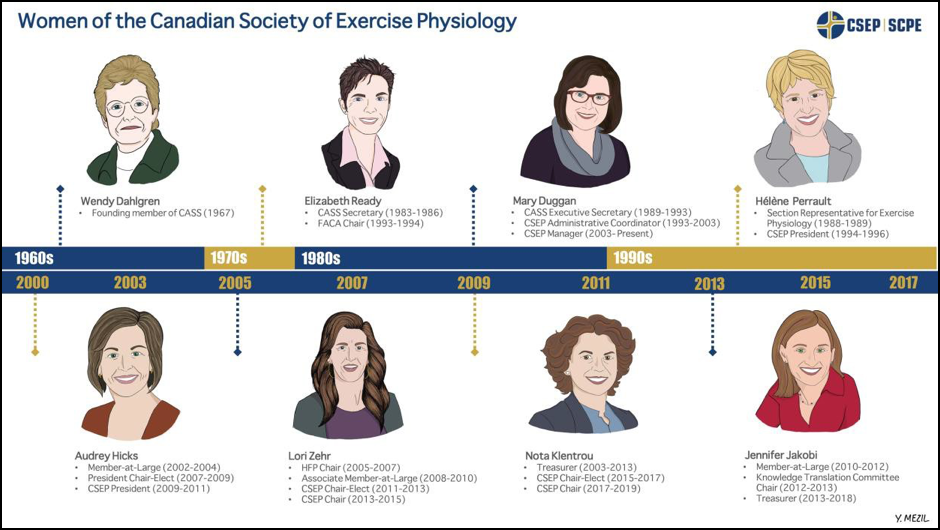May 17, 2018
A look back: Exercise Physiology and CSEP’s first 50 years

The Canadian Society for Exercise Physiology will be celebrating its 50th anniversary in 2017. A signature initiative is a celebration of the contributions of Canadian researchers to exercise physiology over the past 50 years. The objective is to highlight significant Canadian contributors and their contributions to exercise physiology, health and fitness, nutrition and gold standard publications globally as well as provide insights on future research directions in these areas. These achievements have been organized into a series of short historical communiqués on prominent Canadian contributors and will be published on a monthly basis.
Women Leaders of CSEP: A 50th anniversary celebration of major and significant contributions
Adamo, K.1, Hicks, A.2,Hopkins, S.R.3 Klentrou, P.4, Mottola, M.F.5, Perrault, H.6, Zehr, L.7
Illustration: Mezil, Y.8
1School of Human Kinetics, Faculty of Health Sciences, University of Ottawa
2Department of Kinesiology, McMaster University
3Departments of Medicine and Radiology, University of California San Diego
4Department of Kinesiology, Faculty of Applied Health Sciences, Brock University
5School of Kinesiology, Faculty of Health Sciences and Department of Anatomy and Cell Biology, Schulich School of Medicine, University of Western Ontario
6Faculty of Health Sciences, University of Ottawa; Respiratory Clinical Research Unit of the McGill University Health Centre
7 School of Health and Human Services, Camosun College
8Department of Pediatrics, McMaster University
Over the past 50 years CSEP has made amazing progess in women participation. In addition to having excelled in their careers, many women have had the tremendous influence and impact in CSEP’s 50 year history. This article recognizes women who have advanced CSEP as an organization by serving as officers and directors of the Board or Standing Committees, and leading strategic initiatives using mainly a historical perspective with tidbits of biographical highlights.

Figure 1: Timeline of women’s participation in the Board of Directors over CSEP’s 50 year history, including the first women among CASS’s founding members (W. Dahlgren), the first woman on the Board (E. Ready) and all women in executive roles.
During the first two decades, the Canadian Association of Sports Science (CASS) membership did not include many women. Wendy Dahlgren of the University of Manitoba was a founding member of the Canadian Association of Sports Science (CASS) and one of few women who joined the organization in 1967. Wendy Dahlgrenhad an impressive career at the University of Manitoba, where she held a number of leadership positions including Associate Dean of Physical Education and Recreation Studies as well as Acting and Associate Dean of the Faculty of Graduate Studies. She was also president of the Women’s Health Research Foundation of Canada, and of the Canadian Association for Health, Physical Education and Recreation, as well as vice-chair of the Canadian Fitness and Lifestyle Research Institute. Her leadership extended beyond academia. She chaired the President’s Council and Executive Committee of the Assembly of Canadian Special Olympics and was president of Manitoba Special Olympics. She was also a writer and researcher for the CBC television fitness show “Body Talk”.
For the next decade (1969-1979) we find no women in the Society’s Board. It was not until the 80’s when the first woman made way to CASS’s Board of Directors. The first elected woman on the Board was Elizabeth Ready (University of Manitoba), who served as Secretary from 1983-1986. Elizabeth’s debut was followed by Joan Stevenson (Queens University) who held the Treasurer position for two years, from 1986-1988. Subsequently, in 1988-1989, two women made it to the Board as section representatives, Chantal Bard for motor behaviour/motor control and Hélène Perrault (University of Ottawa, McGill University) for exercise physiology. In 1989, Mary Duggan joined CASS as Executive Secretary. Mary came to CASS from the Sport Medicine Council of Canada with a background in management, finance and technical support. She was responsible for coordinating meetings, promotional material and membership services, and in 1993 transitioned to CSEP’s Administrative Coordinator. Ever since, Mary has been the soul and hands of CSEP’s operations, managing the CSEP office, providing support to the Board and overseeing CSEP’s special projects. Since 2003, Mary officially carries the title of CSEP manager.
In the 1990’s, while CASS was giving way to CSEP, women started making their way into the highest positions of the organization. At the same time, they advanced CSEP’s reputation by making significant contributions to exercise physiology research. Many of these women were mentioned in previous articles leading up to CSEP’s 50th anniversary. The next paragraphs will highlight the contributions made by women in CSEP’s leadership.
In 1993-1994, Elizabeth Ready returned to the Board as chair of Fitness Assessment and Accreditation (FACA) program, and Susan Hopkins (University of California, San Diego, UCSD) joined her as chair of the High-Performance Sport Committee. Susan Hopkinshas been investigating the pulmonary system under conditions of stress such as hypoxia and exercise for over 30 years, with particular interest in pulmonary limits to exercise performance. Her unique research interests led her to the UCSD, where she was the first to identify that mechanical stress failure occurred in the pulmonary capillaries of human athletes. She also conducted a number of studies that furthered understanding of the relationship between exercise induced pulmonary edema and pulmonary gas exchange, in particular the role of interstitial pulmonary edema in the development of ventilation-perfusion mismatch. Remarkable remains her animal work showing that across divergent species ventilation-perfusion matching is well preserved. Her work has been supported by an Established Investigator Award from the American Heart Association, and multiple R01 awards from the National Institute of Health. Susan continues to collaborate with researchers across the USA and in Canada and to support CSEP as an associate editor of the CSEP’s flagship journal – Applied Physiology Nutrition and Metabolism (APNM). Susan was followed by Marielle Ledoux (Université de Montréal), who chaired the High Performance Sport Committee for 2 consecutive terms (1995-1999).
A big leap was taken in 1994-1996, when Hélène Perrault was elected as the first woman president of CSEP. As a professor at McGill and a research associate in pediatric cardiology and pulmonary medicine, Hélène was amongst the first contributors to clinical exercise physiology. Bringing various clinical and biological markers of physiological regulation to complement exercise-related assessments, she contributed insights into the extent of functional sequelae such as chronotropic insufficiency or blood volume and blood pressure dysregulations prior to or following surgical repair of congenital heart diseases. She also focused on heart-lung interactions, examining the impact of chronic diseases of the lung on circulatory parameters and of pulmonary function integrity in circulatory disorders. As the first woman president, Hélène contributed to solidifying the branding of the recently formed CSEP, supporting the expansion of its professional certification programs while safeguarding the appropriate contractual framework for the Canadian Journal of Applied Physiology. While serving in several administrative positions first at McGill as chair of the Department Kinesiology and Physical Education (1999- 2006), Associate Provost Planning & Budget (2006-2008) and Dean of the Faculty of Education (2008-2013), and currently at the University of Ottawa as Dean of the Faculty of Health Sciences, Hélène has remained a strong advocate for the roleof physical activity for optimal health and an adjunct in the continuum ofhealth care. By the end of the decade, Louise Béliveau (Université de Montréal) was elected on the Board as member-at-large (1996-1998) and Carol Rodgers (University of Saskatchewan) as vice-president of basic research (1998-2000).
The 21st century brought many women to the CSEP’s leadership. In 2002-2004, Jo Ann Rutledge served as associate member-at-large and Audrey Hicks(McMaster University) as voting member-at-large. Audrey returned to the Board in 2007-2009 as President-Elect eventually becoming the second woman President in 2009-2011. Audrey has been a member of CASS, and then CSEP since the early 80s, and a professor at McMaster University since 1988. Her research has evolved from muscle physiology and mechanisms of fatigue, to exploring the physiological adaptations to exercise in a wide variety of special populations (aging, spinal cord injury, multiple sclerosis). To date, Audrey’s papers have been cited over 8600 times. From 2007-2011 as President-elect and President, she led the organization through the development and release of the new Physical Activity Guidelines for Canadians. This sparked a new research interest in guideline development and becoming involved in the leadership team for developing the Physical Activity Guidelines for Adults with Spinal Cord Injury and the Physical Activity Guidelines for Adults with Multiple Sclerosis. She has been an associate editor for APNM since 2005. One of the hallmark features of Audrey’s academic career is her commitment to putting her research into practice. She is the founding Director of the MacWheelers and MSFitt exercise programs at McMaster University, which are adapted exercise and wellness programs for adults living with SCI or MS in the Hamilton community.
At the same time, Nota Klentrou(Brock University) became the longest serving treasurer in the history of the organization, holding this position for 10 consecutive years from 2003-2013. Nota received her PhD from the Université de Montréal in exercise science, then took a faculty position at Brock University, where she made transformative contributions to the department of Kinesiology and the Brock community. She is currently the Associate Dean Research and Graduate Studies in the Faculty of Applied Health Sciences. Nota’s interdisciplinary research explores the effects of exercise and training on health and performance mainly in children, adolescents, and women, with a recent focus on the hormonal, inflammatory and bone turnover responses to high intensity exercise. Her particular interest in the health of young athletes has led to her involvement with the International Federation of Gymnastics, the Athens 2004 Summer Olympic Games, and the Toronto 2015 Pan-American Games. Nota’s long contribution to CSEP does not stop in carrying the budget through several transformations and turbulences. In 2011, together with CSEP’s President-Elect Lori Zehr, the HFP chair Karyn Humber and Carol Rodgers, she joined the CSEP’s Governance and Financial Management Task Force, which led to the restructuring of CSEP that provided voting privileges and greater representation on committees for the 5,000 certified members. After a 2-year break, Nota has returned to the Board, first as Chair-elect (2015-2017) and currently as CSEP Chair/President (2017-2019).
Lori Zehr(Camosun College) was first elected HFP Chair from 2005-2007. Over her 25- year career as practitioner, academic, and administrator, Lori has championed the role of exercise professionals in promoting behaviours that lead to a more active and healthy population. Lori’s first contributions to Canada’s Physical Activity Guidelines was in 1998/99, as part of a team that created the “Health and Fitness Benefits Chart” to supplement Canada’s Physical Activity Guide to Healthy Active Living. Consequently, from 2006 to 2016 Lori contributed to CSEP’s strategic initiative in Advancing the Future of Physical Activity Measurement and Guidelines, and consistently provided the voice of end-user exercise professionals on Canada’s Physical Activity, Sedentary Behavior, and first ever 24 hour Movement Behavior Guidelines. In 2003, while chairing CSEP’s Exercise Rehabilitation Committee, Lori recognized the need to push forward advances for exercise professionals and led development of the first (clinical track) certification pathway for qualified graduates to provide exercise assessment, prescription, and programming with emerging “at risk” populations (now CSEP Certified Exercise Physiologist© [CSEP-CEP]). Subsequently, from 2004 to 2007, Lori chaired CSEP’s Certification Program and facilitated adoption and recognition of the CSEP-CEP with affiliate associations in Australia and Europe. Institutionally, Lori was recruited to Camosun College in 2006 to develop unique and trending credentials that aligned with CSEP and other industry driven accreditation standards. This distinct programming with CSEP certification endpoints continues to be a flagship forCamosun College and is a testament to Lori’s lifelong dedication, passion, and advocacy for advancing the training and practice of exercise professionals in Canada. The next pivotal period saw Lori Zehr as the third woman President-Elect and President of CSEP (2011-2015), leading the organization through a turbulent transition phase while simultaneously overseeing strategic organizational and governance reviews.
Numerous other women deserve mention. One cannot overlook Karyn Humber’s (University of Guelph-Humber) significant contribution first to the Board as associate member- at-large (2004-2006) and later to the Health and Fitness Program (HFP) as Chair-elect, Chairand Past-chair (2010-2014). Meanwhile, Michelle Porter (University of Manitoba) chaired the Knowledge Translation (KT) committee from 2008 – 2011. The recent decade finds many women in leadership positions. Jennifer Jakobi (University of British Columbia – Okanagan) was elected member-at-large from 2010 to 2012, KT committee Chair from 2012 to 2013, and finally as Treasurer from 2013 to 2018. Cathy Notarius from the Toronto Rehabilitation Institute (2012-2014) and Kathy Gaul from the University of Victoria (2013-2015) also held the position of voting Member-at-large over the same period. Recent additions to the list of women contributors to CSEP’s Board include Kirstin Lane (Camosun College) as vice-chair of Professional Standards (2018-2020), Ginger Lamoureux (Canadian Armed Forces) representing CSEP-CPT (2016-2018), and Shilpa Dogra (University of Ontario Institute of Technology) taking the new position of director of Conferences (2018-2020). This latest composition makes the first gender balanced CSEP Board of Directors in the history of the society with five women on the current eleven-member Board. An equally important contribution to CSEP has been made by the many young women who have chaired the Graduate Student Committee: MelissaThomas(2007), Lianne Dolan (2009), Amanda Rossi (2010), Ayesha Saleem (2011), Anna Vainshtein(2012) and Donna D’Souza (2013).
Creating a list of notable women is very difficult. Many women have already been mentioned above for their contribution to CSEP’s leadership. However, women have also contributed to advancing CSEP as an organization by leading strategic initiatives without serving as officers and directors of the Board. Michelle Mottola is a long-time member of CSEP and a Professor at Western University. Michelle is an anatomist (embryologist) and exercise physiologist who has conducted research on the effects of maternal exercise on both the mother and the developing fetus, with follow up into the postpartum period for over 20 years. Her research led to a co-authorship of the PARmed-X for Pregnancy, which is the Canadian exercise guidelines for pregnant women. Michelle was also co-author on the Clinical Practice Guidelines for Exercise During Pregnancy, which are jointly published by CSEP and the Society of Obstetricians & Gynecologists of Canada (SOGC). The PARmed-X for Pregnancy has been translated into Brazilian Portuguese, and Michelle and colleagues have recently published the specific methodology for translating the PARmed-X for Pregnancy into another language. Michelle wrote the section on exercise during pregnancy for the American College of Sports Medicine, where CSEP’s PARmed-X for Pregnancy Canadian guidelines were peer-reviewed and incorporated (with permission) into the ACSM’s Guidelines for Exercise Testing and Prescription, 9th edition. Michelle was also invited to sit on the Expert Medical Panel for the International Olympic Committee, to develop a consensus statement as a medical guide for the elite pregnant athlete that was recently published in the British Journal of Sports Medicine.
In addition to all the above women who contributed to the society’s mandate, women have been recognized by CSEP for their contribution in science. In 1983, Audrey Hicks received the CASS Young Investigator Award for her masters work under Duncan MacDougall. Subsequently, 31 women were among the finalists for the graduate student oral award, 7 of whom won the award, as well as 3 women winners of the graduate student poster award. Finally, in 2015, Kristi Adamo (University of Ottawa) became the first woman to receive the CSEP Young Investigator Award. Since receiving the CSEP Undergraduate Student Award from the University of Guelph in 1996, Kristi has been a longstanding member and supporter of CSEP. Kristi is not only a CSEP Certified Exercise Physiologist©, but an Associate Professor in the Faculty of Health Sciences (Human Kinetics) and the Faculty of Medicine (Pediatrics) at the University of Ottawa. She is also a founding member and affiliate scientist with the Healthy Active Living and Obesity Research Group at the Children’s Hospital of Eastern Ontario Research Institute where she grew her program of research on Prevention in the Early Years, with a focus on early lifestyle intervention and upstream prevention of childhood obesity. Her team was the first to identify the independent contribution of pregnancy weight gain to neonatal weight and she played a lead role in the development of the Canadian Obesity Network’s – 5As of Health Pregnancy Weight Gain. She leads the only research group in the world studying the relationship between exercise in pregnancy, placenta biology and fetal growth and development. Kristi is also an associate editor of APNM and has contributed to the review and update of the CSEP-CEP certification materials. She is currently involved in the CSEP’s physical activity guideline development process for the early years, as well the clinical exercise guidelines for pregnancy. It is important to note that Kristi is among the many women who have served as associate editors of APMN. In fact, 32 of the 52 associate editors are women, some of whom have already been mentioned, including Audrey Hicks, Susan Hopkins, Jennifer Jakobi, Cathy Notarius, Michelle Porter and Elizabeth Ready.
Certainly, this distinguished list of outstanding women and their remarkable contributions through research, science, academia, practice, advocacy and/or service has inspired and will continue to motivate many more women to be equally dedicated and successful in advancing CSEP related endeavours in the future.





